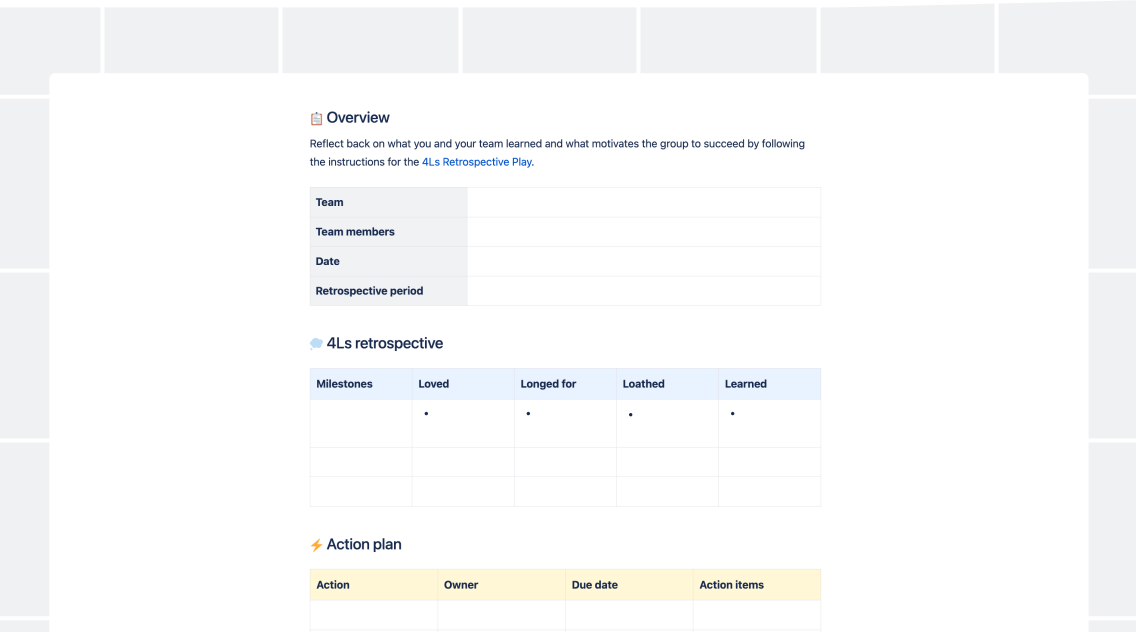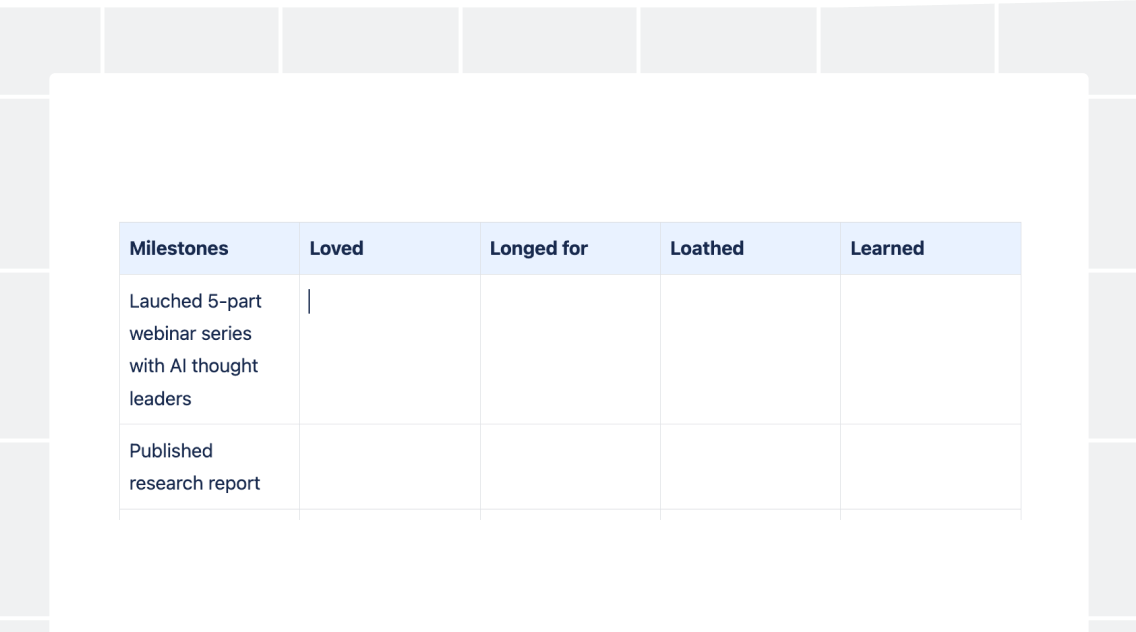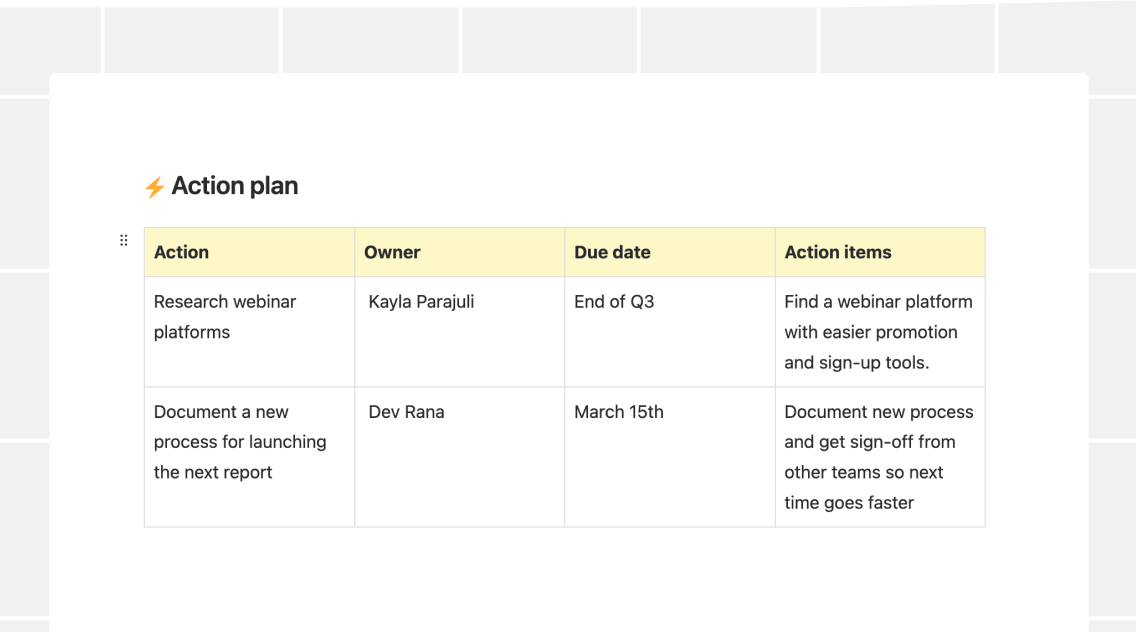4Ls Retrospective
Build a culture of openness and continuous improvement with the 4Ls, a retrospective technique in which team members identify what they loved, loathed, longed for, and learned from a project or sprint of work.

PREP TIME
5m
Run TIME
60m
Persons
2-8
5-second summary
- Reflect on past key milestones.
- Discuss the 4Ls for each milestone.
- Document an action plan to improve.
WHAT YOU WILL NEED
- Video conferencing with screen sharing or meeting space.
- Digital collaboration tool (see templates).
- Optional: physical whiteboard, markers, sticky notes, and timer.
How to run a 4Ls Retrospective
Build a culture of openness and continuous improvement with the 4Ls, a retrospective technique to identify what you loved, loathed, longed for, and learned from a project or sprint of work.
4L 회고란 무엇입니까?
4L 회고는 팀이 향후 프로젝트를 개선하기 위해 완료된 스프린트나 프로젝트를 되돌아보는 데 사용하는 구조화된 피드백 기법입니다.
4L은 좋았던 점(Loved), 싫었던 점(Loathed), 원했던 점(Longed for) 및 배운 점(Learned)을 의미합니다. 각 항목이 나타내는 의미는 다음과 같습니다.
- 좋았던 점: 프로젝트를 진행하는 동안 어떤 부분이 잘 진행되었습니까? 팀원이 높이 평가하거나 즐겼거나 효과적으로 밝혀진 것입니다.
- 싫었던 점: 어떤 부분이 불만족스러웠습니까? 누락된 부분 또는 개선이 필요한 부분은 무엇입니까? 이 범주에서는 부족한 리소스, 기술 또는 지원과 같이 스프린트를 성공으로 이끌 수 있는 공백을 파악합니다.
- 원했던 점: 팀원이 스프린트 기간 동안 원했던 것은 무엇입니까? 더 나은 도구, 더 명확한 요구 사항 또는 추가 시간과 같이 업무의 효율성 및 즐거움을 향상할 수 있는 모든 것이 될 수 있습니다.
- 배운 점: 팀에서 새로 얻은 지식 또는 기술은 무엇입니까? 기술 지식, 더 효과적인 커뮤니케이션 방법, 프로젝트 또는 프로세스에 대한 인사이트일 수 있습니다.
4L 회고 플레이를 운영하는 이유
회고는 지속적 학습을 촉진하여 팀이 워크플로 기술을 개선하고 향후 더 효과적인 프로젝트 제공을 보장할 수 있습니다. 연구에 따르면 정기적으로 회고를 수행하는 팀은 회고를 자주 하지 않거나 아예 하지 않는 팀보다 반응성이 24% 높고 품질은 42% 높으며 변동성은 적습니다.
4L 회고를 사용하는 시기
4L 회고는 다양한 팀 역학, 프로젝트 단계 및 기간에 따라 조정할 수 있습니다. 스프린트 또는 기술 팀이 끝날 때로 국한되지 않으며 프로젝트, 릴리스 또는 중요한 이벤트가 종료될 때 공식적으로 사용하거나 팀 미팅을 개선하기 위해 즉흥적으로 사용할 수도 있습니다.
4L 회고의 3가지 이점
- 균형 잡힌 피드백: 4L 프레임워크는 긍정적인 부분 및 개선이 필요한 부분을 모두 다루어 균형 잡힌 회고를 장려합니다.
- 작업 지향: 4L 프레임워크는 개선이 필요한 특정 영역을 정확히 찾아내므로 향후 스프린트를 위한 목표 작업 계획을 쉽게 만들 수 있습니다.
- 긍정적인 프레이밍: 4L 프레임워크는 회고 중에도 건설적인 분위기를 유지하며 단순히 문제보다는 기회에 초점을 맞춥니다.
1. Prep your team and 4Ls document
1. 플레이 준비 5분
원격 팀의 경우 먼저 Confluence 페이지와 같은 공동 작업 문서를 만듭니다. 사용 가능한 템플릿을 사용하거나 직접 만들 수 있습니다. 대면 팀의 경우 화이트보드 또는 큰 종이를 구하고 회의실에 스티키 메모 및 마커를 준비해 둡니다.
세션을 진행하기 전에 팀이 다 함께 회고 기간을 결정합니다. 회사가 분기별 일정으로 운영되는 경우 지난 분기를 되돌아보는 것이 좋습니다.
마일스톤, 좋았던 점, 싫었던 점, 원했던 점, 배운 점 및 작업이라는 제목으로 여섯 개의 열을 구성합니다.
미팅을 시작할 때 팀에 다음 내용을 커뮤니케이션합니다.
- 오늘의 목적은 효과가 있는 것과 그렇지 않은 것을 되돌아보는 것
- 잘잘못을 따지거나 비난하는 세션이 아님
- 모든 팀원이 사용 가능한 지식과 도구로 최선을 다했음을 인정
이 미팅은 안전한 공간이며 공유하는 인사이트는 누구에게도 불리하게 사용되지 않음
2. Reflect on key milestones
1. 플레이 준비 5분
선택한 기간 중에서 목표 달성, 축하, 신규 팀원 및 회사 이벤트와 같이 중요한 순간을 떠올리도록 팀에 요청합니다. 이렇게 하면 기억과 감정을 회상하기가 수월합니다. 타이머를 설정하여 10분 동안 모두가 마일스톤 열에 주요 이벤트를 추가하도록 합니다.
3. Define the 4Ls
1. 플레이 준비 5분
타이머를 설정하여 10분 동안 모두가 마일스톤마다 4L을 채울 수 있도록 합니다. 시작하기 전에 팀에 다음과 같이 4L에 대해 설명합니다.
- 좋았던 점: 즐거웠으며 계속하고 싶은 것
- 싫었던 점: 즐겁지 않았던 것
- 원했던 점: 있었으면 좋았을 것(예: 리소스, 인력, 참고 자료 등)
- 배운 점: 성공 및 실수를 통해 배운 점
4. Discuss actions to improve
1. 플레이 준비 5분
모두에게 10분 동안 팀으로 또는 소규모 그룹으로 나눠서 결정할 시간을 줍니다.
- 싫었던 점 목록에 있는 항목을 없앨 수 있는 한 가지 작업
-
좋았던 점 목록에 있는 항목을 강화할 수 있는 한 가지 작업
원했던 점 열 및 배운 점 열에 나열된 항목은 앞으로 전념할 작업 항목을 결정하는 데 유용합니다.
팁: 중점을 두세요
수행할 작업이 적을수록 해낼 가능성이 높아집니다. 목록당 하나의 작업 항목으로 시작하세요.
5. Share and capture plans
1. 플레이 준비 5분
각 그룹이 계획을 발표하도록 몇 분 정도 시간을 줍니다. 작업 목록을 사용하여 다음을 기록합니다.
- 작업을 수행할 팀원
- 팀원이 수행할 작업
- 작업을 완료할 시기
Follow-up
Schedule your next 4Ls Play
상태 모니터 체크포인트에 정기적인 케이던스를 설정합니다. 빨간색과 노란색이 초록색 쪽으로 이동하고 있습니까? 초록색 항목 중에서 빨간색으로 이동한 것이 있습니까? 성과를 축하하고 개선해야 할 부분을 해결합니다. 정기적으로 확인하면 추진력을 높게 유지하고 문제가 되는 부분이 큰 피해를 입히기 전에 찾아낼 수 있습니다.

질문이 더 있으신가요?
다른 Atlassian 팀 플레이북 사용자와 대화를 시작하고 지원을 받거나 피드백을 제공하세요.
Other plays you may like
미팅
주간 팀 업데이트
또 다른 미팅을 예약하지 않고도 진행 상황을 공유하세요.
미팅
페이지 중심의 미팅
더 효과적인 미팅은 목적, 예상 결과 및 주요 논의 사항을 요약한 페이지에서 시작됩니다.
커뮤니케이션
사용 설명서
팀원이 여러분과 가장 잘 협업할 수 있는 방법을 이해하도록 지원하세요.
결과 보고
회고
효과가 있었던 점과 없었던 점에 대해 논의할 수 있는 안전한 공간을 제공합니다.
최신 정보 알기
Atlassian 뉴스레터에 가입하여 플레이 및 Work Life에 대한 최신 정보를 받으세요.










